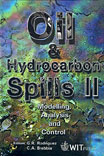Bioavailability And Metabolism Of Pyrene In Sediments With The Polychaete Arenicola Marina
Price
Free (open access)
Transaction
Volume
44
Pages
10
Published
2000
Size
1,055 kb
Paper DOI
10.2495/OIL000081
Copyright
WIT Press
Author(s)
K. Timmermann, M. Christensen, G. T. Banta & O. Andersen
Abstract
After oil pollution events, oil components as PAH may affect biota of near-coastal sediments for extended time periods, and bioturbation by infaunal organisms may affect the fate of PAHs. Modelling of bioavailability of hydrophobic sediment pollutants to aquatic organisms generally assumes that diffusion from water dominate uptake. This is, however, not necessarily true for sediment ingesting infauna. The lugworm Arenicola marina and [^C-4,5,9,10] pyrene were used in experimental benthic microcosms to study infaunal interactions in distribution and metabolism of the PAH fraction of oil and allow quantification of pyrene and its metabolites including ^CC^, in interstitial and overlying water, sediment and worms. Manipulation of the sedi
Keywords





